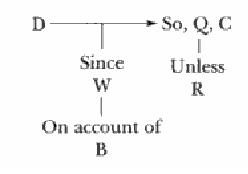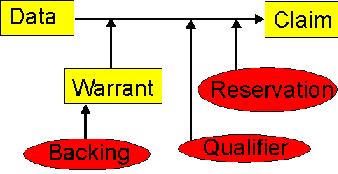Argumentation theory

Argumentation theory
Acronym
N/A
Alternate name(s)
N/A
Main dependent construct(s)/factor(s)
Claim (or Conclusion)
Main independent construct(s)/factor(s)
Data (Facts and Opinions), Warrant (Advancement of Data)
Concise description of theory
The theory of argumentation is descriptive of how people argue. The theory has roots in logic; however, Toulmin developed his theory in order to explain everyday argumentation (Toulmin 1958).
In their description of an argument, Brockriede and Ehninger (1960) refer to Toulmin and describe an argument as “movement from accepted data, through a warrant, to a claim.”
The three main components in argumentation theory include data, warrant, and claim. Data refers to the facts or opinions of evidence. Claim refers to the conclusion. Warrant is the “leap” which advances data to a claim (Brockriede and Ehninger 1960). Specifically Toulmin (1958) says that warrant is “incidental and explanatory, its task being simply to register explicitly the legitimacy of the step involved and to refer it back to the larger class of steps whose legitimacy is being proposed.”
The second set of components is not necessary, but may be present. These additional three components include backing, rebuttal, and qualifier. Backing refers to the evidence or support for assumptions in the warrant. Rebuttal recognizes the conditions under which the claim will not be true. Finally, qualifier is the probability or level of confidence of the claim.
Diagram/schematic of theory
Theory of Argumentation: D represents data, W represents warrant, C represents claim, B represents backing, Q represents qualifier, and R represents reservation. Source: Toulmin (1958)
Source: http://www.unl.edu/speech/comm109/Toulmin/layout.htm
Originating author(s)
Stephen Toulmin
Seminal articles
Toulmin, S. The Uses of Argument, Cambridge University Press, Cambridge, MA, 1958.
Brockriede, W., and Ehninger, D. “Toulmin On Argument: An Interpretation And Application,” Quarterly Journal of Speech (46:1), February 1960, pp. 44-54.
Originating area
Philosophy, Communication, Artificial Intelligence
Level of analysis
Individual/Group
IS articles that use the theory
Baroni, P., Giacomin, M., and Guida, G. “SCC-recursiveness: a general schema for argumentation semantics,” Artificial Intelligence (168:1/2), October 2005, pp. 162-210.
Reed, C., and Rowe, G. “Araucaria: Software For Argument Analysis, Diagramming and Representation,” International Journal on Artificial Intelligence Tools (13:4), December 2004, pp. 961-979.
Verheij, B. “Artificial argument assistants for defeasible argumentation,” Artificial Intelligence (150:1/2), November 2003, pp. 291-325
Links from this theory to other theories
N/A
External links
http://en.wikipedia.org/wiki/Argumentation_theory, Wikipedia entry on argumentation theory
http://www.tcw.utwente.nl/theorieenoverzicht/Levels%20of%20theories/micro/Argumentation%20Theory.doc/, University of Twente entry on argumentation theory
http://www.unl.edu/speech/comm109/Toulmin/index.htm, The Toulmin Project Home Page
http://www.cs.uu.nl/people/henry/research/argtheory.html, Henry Prakken’s webpage on argumentation theory
http://www.yorku.ca/gilbert/argthry/, Michael A. Gilbert’s webpage on argumentation theory
http://homepages.inf.ed.ac.uk/irahwan/argmas/argmas06/, conference about argumentation theory and multi-agent systems
Original Contributor(s)
Alanah Davis
Please feel free to make modifications to this site. In order to do so, you must register.
Return to Theories Used in IS Research

